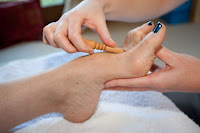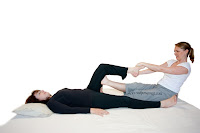What happens after the massage?
This will differ a little depending on the therapist and location. In general, you will be given some time to relax after the massage, before getting off the couch/mat and getting dressed. If there is a separate reception or sitting area you will usually then move there from the massage room.
You will often be offered a drink, as fluid intake is important after a massage.
The therapist will give you a feedback from the massage, and some care advice. This will cover firstly what response to expect from the massage, and how to care for yourself immediately afterwards. You may also be given suggestions to address the issues you came to treat, or which were found during the massage. This might be stretches you can do at home, or diet or exercise advice.
Payment will be taken (if not taken before the massage) and you may be offered the chance to book your next appointment.
What are the after effects of massage?
Massage affects everyone differently, and your reaction will also depend on the treatment you receive. However, there are some general points to look out for.
After your massage, especially a relaxing or de-stressing massage, you should feel calm and rested. This may cause temporary feelings of sleepiness or fatigue.
The muscles and joints of the areas treated should feel looser and more flexible. After a vigorous massage, you may experience aching in the areas treated; this should fade within 24 hours.
You might feel thirsty, and it is recommended you drink plenty of water after the treatment.
Massage can cause a need to urinate more frequently, and/or an increase in bowel movements.
At times massage may produce a heightening of emotions and teariness; if this occurs be compassionate with yourself and take time to acknowledge the feelings.
Occasionally massage can cause flu-like symptoms or headache for up to 24 hours.
These, and other, reactions, are perfectly normal and part of your body processing the changes brought about by massage. However, if you are at all worried about a reaction, speak to your therapist for advice and guidance.
How many sessions will I need?
 |
| It feels great, but how often can you indulge? |
A lot of people choose to have massage on an on-going basis for maintenance or prevention of issues; this can be monthly or every 6 weeks.
Of course, if you have for example, upper back ache from hunching over a computer for 10 hours a day, and after your massage you continue to hunch over a computer for 10 hours a day, you may experience temporary relief but the pain is going to return. This is where your therapist will discuss with you changes you could make to your lifestyle to reduce the strain on your body and mind, helping you to look after yourself.
How often should I have massage?
There is no reason not to have relaxing massage everyday, although this is seldom practical. It is usually advisable to have at least a few days break between remedial massages to allow the body to recover.
For treatment of a particular issue, such as a physical pain or a highly stressful time, massage once or twice a week is recommended for a short period. As this issue is resolved, it is usual to reduce to fortnightly massages, and then to monthly or 6-weekly maintenance or preventative massages. The frequency can be increased again if another specific issue arises.
Of course, you may just want one or two massages as a treat, or to help at a specific time, and this is fine too.
How much should I pay for massage?
Prices for massage will vary according to area, the experience of the therapist and the venue (a luxurious spa will generally cost more than a home-based therapist).
The most important thing is that you feel comfortable with the amount you are paying, and that you are getting value for money. If you feel it is too expensive, you will not be relaxed, or will have unrealistically high expectations of the massage and so inevitably be disappointed. Conversely, paying a low price but not getting an effective massage, or more importantly not feeling that you can trust the therapist, is a false economy.
A word on discounts – if you are looking for a new massage therapist, trying people out when a discount comes up can be a cost effective way to see a range of therapists. However, once you find someone that you like and want to build a relationship with, relying on temporary deals is going to get in the way, and mean you can’t have massages when you need them. It’s preferable to find someone within your price range. Many therapists offer loyalty schemes for regular clients, which may help.
Should I tip?
Tipping is not expected for massage, so there is no need to, your therapist will not be offended or feel they have disappointed if you do not give one.
However, if you feel you have received excellent service, and are really pleased with your treatment, and would like to give a little more, a small tip is usually greatly appreciated (although some clinics have a no tipping policy). As a guideline, round up the fee to the nearest £5, or add up to about £5.
What if I’m not happy with the massage?
As therapists, we always want our clients to walk out of a massage feeling 10 feet tall and dancing on air, but of course, sometimes this won’t happen.
If at all possible, speak up during the massage, so the therapist can respond immediately to your concern, especially if it relates directly to the work. Examples would be if you want a firmer massage, or you don’t feel a problem area has been given sufficient attention. While this can feel a little awkward, and sometimes we’re a bit embarrassed to speak up, this is the best way to get the most from the treatment, which you are, after all, paying for. The most common response will be to adjust the massage as you request; as therapists we’re usually grateful for feedback. Sometimes the therapist may not agree, but should explain why they don’t think that action is appropriate.
After the massage, you may decide that the therapist isn’t for you and simply not use them again. Alternatively, if you do want to express your unhappiness, your first option is to speak to the therapist, whether at the end of the appointment or at a later point, to explain the problem. Although they can’t change your experience, they can take the feedback on board for the future, and provide any relevant explanation. The outcome will obviously depend a lot on the circumstances, but if appropriate they may agree to a refund or discount on a future treatment. Bear in mind that refunds will not be given if you didn’t like the particular style of that therapist, or based on your expected outcome, but may be if the massage was not what was described and agreed between you at the outset.
If the therapist is not able to resolve the issue to your satisfaction, and they are employed by a clinic or equivalent, your next option is to speak to their manager.
In serious cases that can’t be settled this way, you can take your complaint to the professional body (assuming the therapist is a member of one) for resolution.
What if I don’t like the therapist?
Don’t see them again, find someone who you do feel a rapport with. Massage requires a trusting relationship, and for both parties to feel comfortable. Sometimes people just don’t hit it off; if this is one of those times, just move on. The therapist will understand that, although there is no need to explain if you don’t want to. It can work the other way too, so if a therapist suggests you see a colleague, don’t take it personally. Of course, it is equally likely that they have referred you as they think someone else’s skills are better suited to provide what you need.
How do I make the benefits of massage last as long as possible?
 |
| Try to take time out before and after your massage |
After the massage, again try not to rush straight back into the hustle and bustle of life. If you can (and depending on the time of your massage) take the rest of the day out, relaxing or doing things that you find fulfilling. Even if this is not possible, sit quietly for a while, maybe read a book, or go for a herbal tea (not coffee) before going back to work. In this way you prolong the feeling of “me time”, and let your body and mind enjoy the respite from stress and strain (physiological and psychological) that massage provides.
Fluid intake is important after a massage; slight dehydration can bring on mild headaches or a “fuzzy” head. Water, herbal tea or weak juices are all good; avoid tea or coffee, or alcohol.
Massage will have brought movement and freedom into your body, but if it has formed the habit of being tight and restricted, it may “try” to revert to this state automatically. You can discourage this by maintaining gentle movement, exploring the range of motion you have in the muscles and joints, and so giving your body time to adapt to a new state. However, gentle is the key word here. Overreaching your comfortable range, by pushing a movement, lifting something heavy or “flinging” a limb around, can do more harm than good. While your muscles are relaxed and loosened, so you can move more than you are maybe used to, the risk of damaging a muscle through trying to over-use it, is increased. So take it easy, no exertion after a massage. It is usually best to avoid exercise for the rest of the day, although there are exceptions, such as pre-exercise sports massage. If in doubt, discuss with your therapist.
The last point is that the effects of massage can be cumulative, so if you are able, see your therapist again while you are still feeling some benefit. In this way you and your therapist together can bring about an on-going improvement in your well-being.






